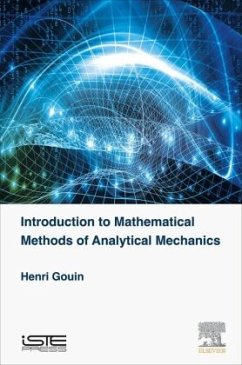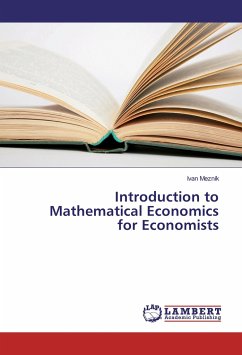Mathematical Methods of Analytical Mechanics uses tensor geometry and geometry of variation calculation, includes the properties associated with Noether's theorem, and highlights methods of integration, including Jacobi's method, which is deduced. In addition, the book covers the Maupertuis principle that looks at the conservation of energy of material systems and how it leads to quantum mechanics. Finally, the book deduces the various spaces underlying the analytical mechanics which lead to the Poisson algebra and the symplectic geometry.
"In this book, an introduction to the calculus of variations is presented and some applications to analytical mechanics are pointed out. In the last part of the book, a lot of problems and exercises are proposed and detailed solutions of them are given, which makes this book suitable for students in the latter years of a mathematics and physics degree.
The geometric methods used in the calculus of variations are presented in the first part of the book, 'In troduction to the Calculus of Variations'. Chapter 1, 'Elementary Methods to the Calculus of Variations', starts with the presentation of the free extremum problem and the constrained extremum problem. Then, methods to find extremum of a free functional and for a constrained functional are deduced. Moreover, the Euler equations are derived. Particularly, the Euler equations become Lagrange equations via the Hamilton principle. The chapter ends with an application, namely the geodesics of a surface.
In Chapter 2, 'Variation of Curvilinear Integrals', the methods described in the previous chapter are extended to the calculation of the variation of curvilinear integrals. The deformation vector field of a curve associated with a family of curves is introduced. Then the variation of the circulation of a vector field is computed. Two applications are discussed: the optical path followed by light in a medium with a variable refractive index and the problem of isoperimeters.
In Chapter 3, 'The Noether Theorem', the notions of Lie group and invariant integral under a Lie group are introduced. In addition, the Noether theorem is proved. As example, Fermat's principle leads to a first integral for the above-mentioned application in optics.
Part 2 of the book, 'Applications to Analytical Mechanics', starts with Chapter 4, 'The methods of Analytical Mechanics'. The concepts of virtual displacement, holonomic constraint, and non-holonomic constraint are presented and the Lagrange equations in the general case of holonomic and non-holonomic constraints are deduced, via d'Alembert's principle. In addition, the linearized motion equation of vi brating string is obtained and studied. Then the Hamilton equations of motion are presented. Using the Maupertuis principle, two applications are considered, namely the case of a material point and introduc tion to the Riemannian geometry. In Chapter 5, 'Jacobi's Integration Method', the integration methods for equations in mechanics are analyzed using Jacobi method and its application in the important case of Liouville's integrability. In the case of the motion of a material point with mass in the three-dimensional space, the generating Jacobi function is obtained in the cases of Cartesian coordinates, cylindrical representation, and spherical representation. The action-angle variables are introduced. As example, the three-dimensional harmonic oscillator is considered. Part 2 ends with Chapter 6, 'Spaces of Mechanics-Poisson Brackets'. Different equivalent configurations of spaces in analytical mechanics are pointed out. The concepts of symplectic scalar product of vectors, dynamical variable, Poisson bracket, first integral are introduced. Some properties of the Poisson bracket are discussed.
The third part, 'Properties of Mechanical Systems', presents some applications of differential equations to mechanical systems. In Chapter 7, 'Properties of the Phase Space', the case where the Hamiltonian does not explicitly depend on time is considered. The flow of a dynamical system is defined. The Liouville theorem, regarding the conservation of the volume in the phase space, is proved. Furthermore, the Poincaré recurrence theorem is discussed. The main properties are presented in Chapter 8, 'Oscillations and Small Motions of Mechanical Systems'. First, some examples highlight the distance between two solutions of a differential equation. Then, the small motions of mechanical systems are analyzed using the Weierstrass discussion of the equation q¨ = g(q), where q is a real function of the real variable t, and g is a real function of variable q which depends on the integration constants of motion given by linear first integrals. Afterwards, equilibrium position of an autonomous differential equation and its stability are presented. Moreover, the linearization of a differential equation is analyzed. Small oscillations of a Lagrangian dynamical system and their frequencies are studied. This chapter end with the study of perturbed equation associated with linear differential equation.
The last chapter, 'The Stability of Periodic Systems', gives a discussion on the stability of periodic systems and the topology of phase space. Some properties of the flow for periodic equations are proved. The concepts of Lyapunov stability and asymptotic stability are extended in the case of periodic systems. The planar case of periodic system x? = f(t)x, where f is a periodic function, is analyzed. Particularly, the notion of strong stability for such systems is introduced. A detailed study of the Mathieu and Hill equations is given." --zbMath, 2020, Cristian Lazureanu, reviewer, expert opinion
The geometric methods used in the calculus of variations are presented in the first part of the book, 'In troduction to the Calculus of Variations'. Chapter 1, 'Elementary Methods to the Calculus of Variations', starts with the presentation of the free extremum problem and the constrained extremum problem. Then, methods to find extremum of a free functional and for a constrained functional are deduced. Moreover, the Euler equations are derived. Particularly, the Euler equations become Lagrange equations via the Hamilton principle. The chapter ends with an application, namely the geodesics of a surface.
In Chapter 2, 'Variation of Curvilinear Integrals', the methods described in the previous chapter are extended to the calculation of the variation of curvilinear integrals. The deformation vector field of a curve associated with a family of curves is introduced. Then the variation of the circulation of a vector field is computed. Two applications are discussed: the optical path followed by light in a medium with a variable refractive index and the problem of isoperimeters.
In Chapter 3, 'The Noether Theorem', the notions of Lie group and invariant integral under a Lie group are introduced. In addition, the Noether theorem is proved. As example, Fermat's principle leads to a first integral for the above-mentioned application in optics.
Part 2 of the book, 'Applications to Analytical Mechanics', starts with Chapter 4, 'The methods of Analytical Mechanics'. The concepts of virtual displacement, holonomic constraint, and non-holonomic constraint are presented and the Lagrange equations in the general case of holonomic and non-holonomic constraints are deduced, via d'Alembert's principle. In addition, the linearized motion equation of vi brating string is obtained and studied. Then the Hamilton equations of motion are presented. Using the Maupertuis principle, two applications are considered, namely the case of a material point and introduc tion to the Riemannian geometry. In Chapter 5, 'Jacobi's Integration Method', the integration methods for equations in mechanics are analyzed using Jacobi method and its application in the important case of Liouville's integrability. In the case of the motion of a material point with mass in the three-dimensional space, the generating Jacobi function is obtained in the cases of Cartesian coordinates, cylindrical representation, and spherical representation. The action-angle variables are introduced. As example, the three-dimensional harmonic oscillator is considered. Part 2 ends with Chapter 6, 'Spaces of Mechanics-Poisson Brackets'. Different equivalent configurations of spaces in analytical mechanics are pointed out. The concepts of symplectic scalar product of vectors, dynamical variable, Poisson bracket, first integral are introduced. Some properties of the Poisson bracket are discussed.
The third part, 'Properties of Mechanical Systems', presents some applications of differential equations to mechanical systems. In Chapter 7, 'Properties of the Phase Space', the case where the Hamiltonian does not explicitly depend on time is considered. The flow of a dynamical system is defined. The Liouville theorem, regarding the conservation of the volume in the phase space, is proved. Furthermore, the Poincaré recurrence theorem is discussed. The main properties are presented in Chapter 8, 'Oscillations and Small Motions of Mechanical Systems'. First, some examples highlight the distance between two solutions of a differential equation. Then, the small motions of mechanical systems are analyzed using the Weierstrass discussion of the equation q¨ = g(q), where q is a real function of the real variable t, and g is a real function of variable q which depends on the integration constants of motion given by linear first integrals. Afterwards, equilibrium position of an autonomous differential equation and its stability are presented. Moreover, the linearization of a differential equation is analyzed. Small oscillations of a Lagrangian dynamical system and their frequencies are studied. This chapter end with the study of perturbed equation associated with linear differential equation.
The last chapter, 'The Stability of Periodic Systems', gives a discussion on the stability of periodic systems and the topology of phase space. Some properties of the flow for periodic equations are proved. The concepts of Lyapunov stability and asymptotic stability are extended in the case of periodic systems. The planar case of periodic system x? = f(t)x, where f is a periodic function, is analyzed. Particularly, the notion of strong stability for such systems is introduced. A detailed study of the Mathieu and Hill equations is given." --zbMath, 2020, Cristian Lazureanu, reviewer, expert opinion








